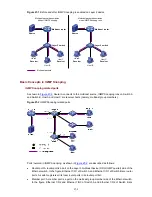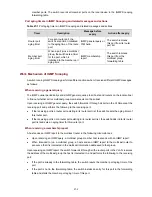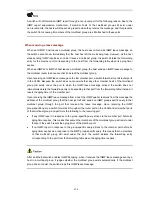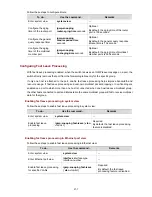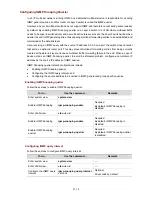
27-7
Follow these steps to configure timers:
To do...
Use the command...
Remarks
Enter system view
system-view
—
Configure the aging
timer of the router port
igmp-snooping
router-aging-time seconds
Optional
By default, the aging time of the router
port is 105 seconds.
Configure the general
query response timer
igmp-snooping
max-response-time
seconds
Optional
By default, the general query response
timeout time is 10 seconds.
Configure the aging
timer of the multicast
member port
igmp-snooping
host-aging-time seconds
Optional
By default, the aging time of multicast
member ports is 260 seconds
Configuring Fast Leave Processing
With fast leave processing enabled, when the switch receives an IGMP leave message on a port, the
switch directly removes that port from the forwarding table entry for the specific group.
If only one host is attached to the port, enable fast leave processing helps improve bandwidth and
resource usage. If fast leave processing and unknown multicast packet dropping or non-flooding are
enabled on a port to which more than one host is connected, when one host leaves a multicast group,
the other hosts connected to port and interested in the same multicast group will fail to receive multicast
data for that group.
Enabling fast leave processing in system view
Follow these steps to enable fast leave processing in system view:
To do...
Use the command...
Remarks
Enter system view
system-view
—
Enable fast leave
processing
igmp-snooping fast-leave
[
vlan
vlan-list
]
Required
By default, the fast leave processing
feature is disabled.
Enabling fast leave processing in Ethernet port view
Follow these steps to enable fast leave processing in Ethernet view:
To do...
Use the command...
Remarks
Enter system view
system-view
—
Enter Ethernet port view
interface interface-type
interface-number
—
Enable fast leave processing
for specific VLANs
igmp-snooping fast-leave
[
vlan vlan-list
]
Required
By default, the fast leave
processing feature is disabled.










